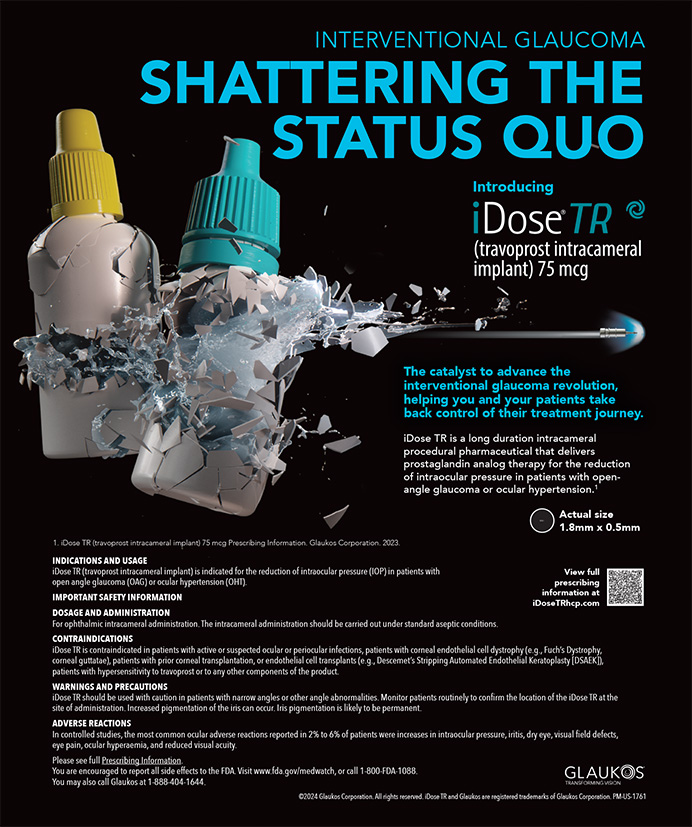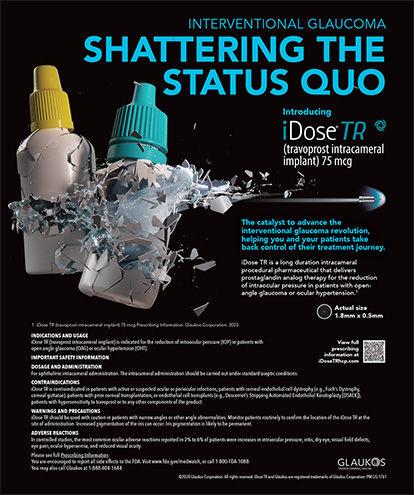

Heads-up Cataract Surgery: Complication Rates, Surgical Duration, and Comparison With Traditional Microscopes
Weinstock RJ, Diakonis VF, Schwartz AJ, Weinstock AJ1
Industry support: No
ABSTRACT SUMMARY
Weinstock and colleagues reviewed surgical data to determine differences in complication rates (posterior capsular rupture and vitreous prolapse) and length of surgery when a 3D, 4K, high-definition display (Ngenuity 3D visualization system, Alcon) or a traditional binocular microscope was used during cataract surgery. This retrospective case series included 2,320 eyes (1,673 eyes in the 3D group and 647 eyes in the traditional group). Cataract surgery was performed by a single surgeon at a single center between August 2016 and July 2017.
Study in Brief
This retrospective case series suggests that complication rates and length of surgery are similar whether a 3D visualization system or a traditional microscope is used during cataract surgery.
WHY IT MATTERS
Improving ergonomics in the clinic and OR may reduce the morbidity associated with chronic, repetitive, unnatural body positioning. Heads-up 3D visualization systems may prevent cumulative spinal injury. In this study, use of a 3D visualization system instead of a traditional binocular microscope did not result in an increased rate of complications or a longer surgical time associated with cataract surgery.
Complications occurred in 12 eyes (0.72%) in the 3D group and five eyes (0.77%) in the traditional group. Mean surgical time was 6.48 ±1.15 minutes in the 3D group and 6.52 ±1.38 minutes in the traditional group. Differences in complication rates and surgical duration were not statistically significant (P > .05).
DISCUSSION
Repetitive physical stress is associated with a high rate of morbidity for ophthalmologists,2-4 who spend much of the workday in ergonomically challenging positions to ease the burden on patients and to enhance intraoperative visualization. Assuming a more relaxed spinal posture during surgery may reduce the currently high incidence of vertebral complications among ophthalmologists.
Retrospective and prospective analyses have demonstrated the safety and utility of using a 3D display system during posterior segment surgery.5 Weinstock has previously described heads-up cataract surgery in which a 3D, 4K high-definition display was used in lieu of traditional microscope oculars for surgical field visualization.6
In the current study, complication rates and operative times did not differ significantly between cases performed when a 3D viewing system or a traditional microscope was used. Heads-up 3D surgery may prevent spinal pathology that often affects ophthalmologists and thereby help prolong their careers. Further analysis of the outcomes of complex anterior segment procedures with both viewing instruments would be valuable.
Effect of Spherical Equivalent Error on Visual Acuity at Various Distances in Eyes With a Trifocal Intraocular Lens
Hayashi K, Sato T, Igarashi C, Yoshida M7
Industry support: No
ABSTRACT SUMMARY
Investigators assessed the effect of residual manifest refraction spherical equivalent (MRSE) error on visual acuity in 60 eyes of 30 patients undergoing bilateral implantation of the AcrySof IQ PanOptix Trifocal IOL (TFNT00, Alcon). The researchers measured patients’ corrected visual acuity from far to near with an all-distance vision tester after simulating the spherical equivalent error by adding spherical lenses with refractive powers of +1.00 D and +0.50 D (slight myopia), 0.00 D (no lens or emmetropia), and -0.50 D and -1.00 D (slight hyperopia).
Study in Brief
Investigators explored the effects of different manifest refraction spherical equivalent errors on visual acuity at various distances in patients who underwent bilateral implantation of a trifocal IOL.
WHY IT MATTERS
The only trifocal IOL available in the United States received FDA approval in August 2019, but this lens has been used for several years internationally. Successful implementation of this technology requires careful analysis of the effect of residual spherical equivalent in several focal planes. These investigators suggest that, although the primary refractive endpoint in trifocal IOL implantation should be emmetropia, surgeons should err on the side of a slightly myopic rather than a slightly hyperopic endpoint to enhance patient satisfaction at all distances.
Mean visual acuity at all distances differed significantly among the groups with spherical lenses added (P ≤ .0374). Mean distance visual acuity at infinity, 5 m, and 3 m was significantly worse in all lens-added groups (+1.00 D, +0.50 D, -0.50 D, -1.00 D) compared to the no-lens group (P < .0001). Mean intermediate visual acuity at 1 m and 0.7 m did not differ significantly between the groups, whereas mean near visual acuity at 0.3 m was significantly better in the groups with slight myopia and significantly worse in the groups with slight hyperopia compared to the no-lens group (P ≤ .0044).
DISCUSSION
In general, cataract surgeons consider a slightly myopic residual refractive error to be preferable to a slightly hyperopic residual refractive error. A careful analysis of the effects of uncorrected refractive error can improve surgical planning and help cataract surgeons to achieve the best possible refractive outcomes with IOLs.
The FDA’s approval of the AcrySof IQ PanOptix IOL has allowed US surgeons to offer trifocal IOL technology to their patients. Careful preoperative planning helps surgeons to meet the expectations of patients receiving multifocal IOLs. The effects, however, of residual refractive error at varying distances after bilateral implantation of an AcrySof PanOptix IOL had not previously been reported.
In this study, Hayashi et al demonstrated that an MRSE of slight myopia significantly improved near visual acuity but worsened distance visual acuity in eyes that had received a trifocal IOL. In contrast, a spherical equivalent error of slight hyperopia significantly worsened both distance and near visual acuity. According to the researchers, although emmetropia is the ideal refractive target in patients undergoing cataract extraction and implantation of a trifocal IOL, a slightly myopic outcome provides a wider range of useful UCVA than does a slightly hyperopic outcome. One strategy that may prove useful in bilateral implantation of trifocal IOLs is to target emmetropia in the dominant eye and slight myopia (-0.25 D) in the nondominant eye as a way to enhance binocular function across a range of working distances.
Of note, this was an exploratory, experimental study with simulated MRSEs, so these data should be analyzed carefully before clinical implementation.
1. Weinstock RJ, Diakonis VF, Schwartz AJ, Weinstock AJ. Heads-up cataract surgery: complication rates, surgical duration, and comparison with traditional microscopes. J Cataract Refract Surg. 2019;35(5):318-322.
2. Chatterjee A, Ryan WG, Rosen ES. Back pain in ophthalmologists. Eye (Lond). 1994;8(pt 4):473-474.
3. Dhimitri KC, McGwin G Jr, McNeal SF, et al. Symptoms of musculoskeletal disorders in ophthalmologists. Am J Ophthalmol. 2005;139(1):179-181.
4. Chams H, Mohammadi SF, Moayyeri A. Frequency and assortment of self-report occupational complaints among Iranian ophthalmologists: a preliminary survey. MedGenMed. 2004;6(4):1.
5. Kumar A, Hasan N, Kakkar P, et al. Comparison of clinical outcomes between “heads-up” 3D viewing system and conventional microscope in macular hole surgeries: a pilot study. Indian J Ophthalmol. 2018;66(12):1816-1819.
6. Weinstock RJ. Heads up cataract surgery with the True Vision 3D display system. In: Weinstock RJ, ed. Surgical Techniques in Ophthalmology-Cataract Surgery. Jaypee-Highlights Medical Publishers; 2009:124-128.
7. Hayashi, K, Sato T, Igarashi C, Yoshida M. Effect of spherical equivalent error on visual acuity at various distances in eyes with a trifocal intraocular lens. J Refract Surg. 2019;35(5):274-279.




